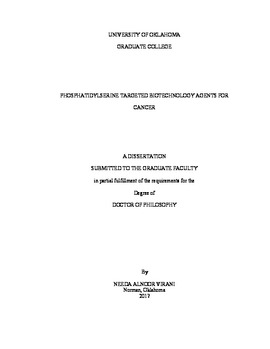| dc.contributor.advisor | Harrison, Roger | |
| dc.contributor.author | Virani, Needa | |
| dc.date.accessioned | 2017-08-23T14:22:47Z | |
| dc.date.available | 2017-08-23T14:22:47Z | |
| dc.date.issued | 2017-08-16 | |
| dc.identifier.uri | https://hdl.handle.net/11244/51918 | |
| dc.description.abstract | Cancer is a highly mutating disease that quickly develops resistance to chemotherapies and has a high rate of relapse. If detected early, the survival rate is greater than 90% for most cancers; however if diagnosed during late, metastatic stages survival rate falls sharply to only 10%. Most cancer therapy is delivered systemically with no targeting specificity, which leads to high accumulation in healthy tissue and eventual toxicity. The high toxicity caused by current chemotherapeutics is a key limiting factor in complete eradication of tumors. Another key limiting factor is the development of resistive tumors. A large number of patients undergo multiple rounds of chemotherapy and surgery with the eventual progression into terminal stage cancer due to the development of resistive tumors.
Phosphatidylserine (PS) composes 8 -15% of the total phospholipids that make up the plasma membrane of a mammalian cells. In normal, healthy cells, PS is asymmetrical and only expressed on the inner leaflet of the membrane. In apoptotic cells, PS is exposed on the extracellular surface of the membrane as an “eat me” signal for immune cells such as macrophages to initiate immune suppressive clearance. Viable cancer cells use PS in a similar manner by expressing it on the external leaflet of the plasma membrane along with other “don’t eat me” signals to promote an immunosuppressive environment without clearance. Due to this externalization, PS can be used as a specific target for biotechnology agents. Annexin V (ANXA5), a mammalian protein, specifically binds to PS in vitro as well as in vivo. ANXA5 can be use to target biotechnology agents, such as nanoparticles and molecular drugs, specifically to the tumor. This thesis focuses on the use of the strong interaction between PS and ANXA5 in biotechnology agents for cancer. | en_US |
| dc.language | en_US | en_US |
| dc.subject | Cancer | en_US |
| dc.subject | Phosphatidylserine | en_US |
| dc.subject | Annexin V | en_US |
| dc.title | Phosphatidylserine Targeted Biotechnology Agents for Cancer | en_US |
| dc.contributor.committeeMember | Safiejko-Mroczka, Barbara | |
| dc.contributor.committeeMember | Hurst, Robert | |
| dc.contributor.committeeMember | O'Rear, Edgar | |
| dc.contributor.committeeMember | Sikavitsas, Vassilios | |
| dc.date.manuscript | 2017-08-16 | |
| dc.thesis.degree | Ph.D. | en_US |
| ou.group | College of Engineering::Department of Bioengineering | en_US |
